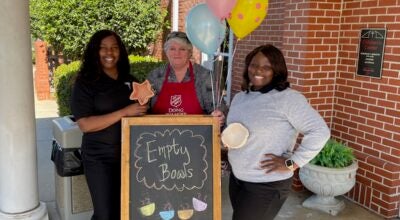All about haints
Published 9:28 pm Friday, September 25, 2009
What goes around comes around.
That’s an old adage that has, over the years, proven to be right about many things.
But who would have ever thought that it would prove true about a superstition that was rooted in Africa, spread to Europe, then on to America where it “took hold” in the rural, deep South.
In a nutshell, that’s how bottle trees came to America.
The colorful bottle trees actually date back to the 9th century in the Congo area of Africa but some folklorists speculate that bottle trees cropped up around 1600 B.C. in Egypt and Mesopotamia because hollow glass bottles were in existence at that time.
When and where trees began to be decorated with bottles is debatable but their popularity in the rural South is not.
The practice of decorating trees with colored bottles was probably imported into the rural South by African slaves, much as the Germans brought along hex signs to decorate their barns. And, just as the hex signs were thought to possess magic powers, so were the bottle trees.
The legend of the bottle trees was that evil spirits, imps or haints were attracted to the bottles by their vivid colors. Once the spirits entered the bottles, they could not turn around and make their way back out. The captured spirits would be destroyed the next day by the sunshine, therefore, ridding the family of any evil spirits on the prowl.
Now, in today’s world that belief seems rather archaic and not many folks would admit to adhering to such a thing. So, what’s with all the bottle trees that are branching out all over the country?
Bottle trees are popping up everywhere from the outer banks of North Carolina to the hinterlands of Ohio and the sandy beaches of California. And, the rural South has reclaimed its place as a hotbed of bottle trees and Pike County is hanging in there.
Barbara Ward, co-owner of Inside Out in Troy, said the popularity of the bottle trees is amazing.
“I had a man come in the other day to get a bottle tree,” Ward said. “He said his wife wanted one and he didn’t have any idea why.”
Ward said many of the purchases are made by members of the older generation but a lot of young people are buying bottle trees, too.
She thinks most of the buyers are aware of the folklore surrounding the bottle tree.
“But I don’t think they are buying them to capture spirits,” she said, laughing.
The shop’s bottle trees are from Bottle Bob in Marbury and come in all shapes and sizes. “The bottle trees aren’t actually trees,” Ward said.
“They are made from iron and some are garden ornaments and some are for home decorating. Bottle Bob even makes chandeliers and table trees. He uses different colored bottles but blue seems to be the most popular.”
And according to bottle tree folklore, there’s reason for it.
Blue has long been associated with ghosts, spirits and haints.
There’s even a blue paint used around windows and doors of houses to repel the spirits, call “haint blue,” said Brundidge metal sculptor Ronald Godwin, who has become sort of an authority on bottle trees since he was commissioned to sculpt a tree for a lady in Skipperville who wanted a bottle tree with an artistic bent.
“Actually, bottle trees are all about haints,” Godwin said, laughing. “Superstition is pervasive the world over, existing in all human cultures since the beginning of recorded history. Halloween is a traditional American celebration in recognition of ghosts, goblin and haints.”
Godwin said it’s often believed that haints exist even though mortal humans can’t see them but, from time to time, are aware of their presence.
“We hear those unusual snap, crackle and pop sounds that seem to occur when activity slows down and we start to get quiet,” Godwin said.
“Coyotes and wolves howl, dogs bark, cats bristle, owls hoot and cows bellow and it’s all about haints. Animals know haints by their keen sense of awareness that humans have yet to develop.”
Godwin said the belief is that since humans can’t perceive spirits like animals do, humans start to imagine all sorts of things at which point a lot of fabrication begins to take place in the imagination about spirits and haints that swirl around in the environment.
“Bottle trees seem to have made the leap from primitive cultures to today’s world,” he said.
“The bottle tree, once known as the poor man’s stained glass, not only serves as interesting decoration for the yard, house and bungalow, but either repels evil spirits or attracts good spirits. It’s up to the owner to decide the individual purpose of the bottle tree.”
As for Godwin, his bottle trees are, simply or not so simply, works of art.
“I’ve taken the primitive folklore idea and escalated it to my form of sculpture,” he said.
“It’s a little more classical in form and expression. My bottle trees make a statement based on a folklore idea through abstract, modern art in the style and technique of my own work.”
One of Godwin’s bottle trees is titled “Dance of the Hummingbird” in recognition of the little bird that swirls around gardens “amongst the beauty of the gardens and the spirits that are all around.”
Another is titled “Bottle Blossom” and is an explosion of bottle beauty that attracts, spirits and or haints but also the sparkling sunlight and the magnificent sunsets in the bottles that adorn his trees.
“It took a year’s supply of Scotch to decorate these trees,” he said and added laughing.
“But these miniature bottles readily capture the beauty of light and probably a host of haints.”



